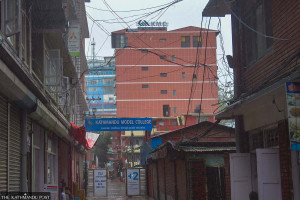Valley
Cement use in Jaya Bageshwori restoration draws criticism
In yet another misstep in the reconstruction of heritage sites damaged by 2015 Gorkha Earthquakes, use of cement in the rebuilding of the historic Jaya Bageshwori Temple in Pashupati has drawn a widespread criticism from locals and heritage conservationists.
Anup Ojha & Sanjit Bhakta Pradhananga
In yet another misstep in the reconstruction of heritage sites damaged by 2015 Gorkha Earthquakes, use of cement in the rebuilding of the historic Jaya Bageshwori Temple in Pashupati has drawn a widespread criticism from locals and heritage conservationists.
The temple, according to some estimates, is one of the oldest temples of Kathmandu Valley.
The quake-damaged temple falls under the purview of the Pashupati Area Development Trust (PADT) and the Department of Archaeology, but both bodies claimed ignorance over the reconstruction process. The current reconstruction had been sponsored by a private donor. According to both the departments, the contractor working on the reconstruction did not have any prior experience working with heritage sites.
According to the Ancient Monument Preservation Act, any buildings over a hundred years old have to be preserved in their original form.
Jaya Bageshwori was one of the hundreds of heritage sites damaged by the 2015 earthquakes. Following the tremors, the two-storey temple had lost its Gajur (pinnacle) and its structure was left tilted to the east.
Locals who reached the site to protest the haphazard renovation using cement also expressed alarm over how the scaffolding placed to support the temple were damaging the priceless tundals (struts) and carvings of the temple.
“It has been over two years [after the earthquake], but the PADT has not shown any interest to renovate this temple,” said Jagadish Vaidya, a local. “Instead, it has given the responsibility to a donor who does not have any knowledge of the temple’s archaeological value.”
Vaidya further said that due to the sorry state of the temple, many devotees visit the premises in constant fear. “The PADT is neglecting its duty, and this is a great injustice for all devotees,” said Vaidya.
“This is a high level of negligence from the authorities. If only the PADT had kept record of the quake damaged temple with frequent surveillance and used its engineers for timely reconstruction and renovation, the temple would have seen a facelift in its original form,” said Binita Magaiya, a conservation architect, who fears that some of the damage done to the temple might be irreversible.
When the Post contacted Ramesh Upreti, the director at the PADT, he said, the PADT gave permission to the local donor after he came with a proposal to reconstruct the damaged temple.
“But the contractor the donor hired was not a professional. We have stopped the construction work after it was brought to our attention,” said Upreti.
He also said the PADT was going to hold a meeting with the officials from the DoA on Wednesday, and await further instructions.
The PADT had also drawn flaks after it demolished one of the four Shivalayas at the Pashupatinath temple to make way for a new building five months ago. The latest incident follows a string of missteps in the renovation of heritage sites after the 2015 quakes. Previously, works at sites like Rani Pokhari, Kasthamandap and the Jaisi Dega Temple were halted after local protested haphazard reconstruction work done by inexperienced contractors hired through a “lowest-bidder” system.




 23.7°C Kathmandu
23.7°C Kathmandu

.jpg)














